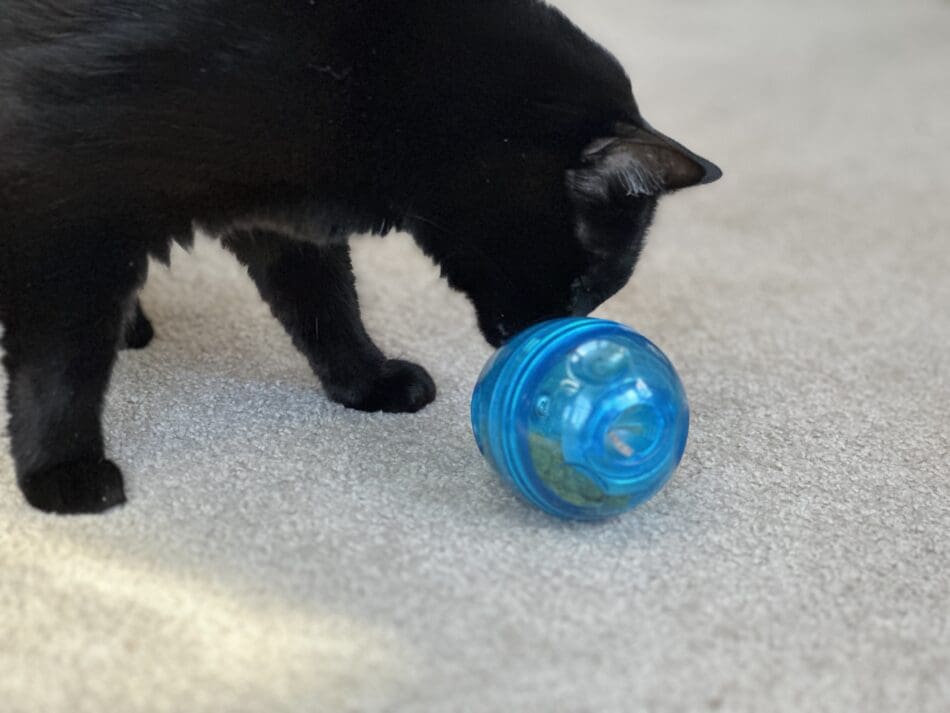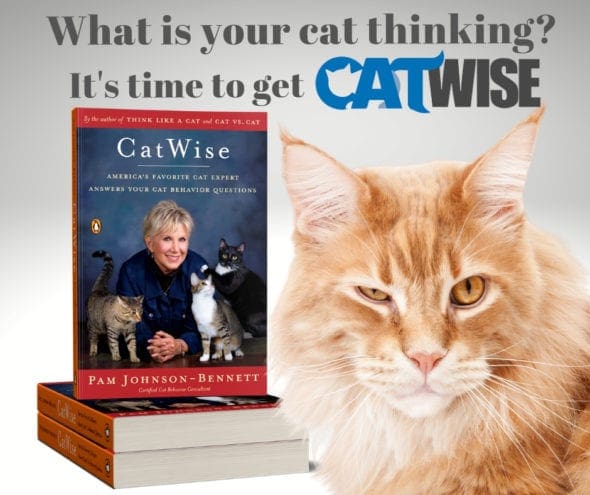
I am always amazed at the number of overweight cats I see during my in-home behavior consultations. What’s even more surprising is that many of the cat parents are unaware their cats are even considered to be overweight. Many people also don’t realize the health risks associated with obesity in humans can apply to our feline family as well. Your overweight cat is at risk for diabetes, heart disease, and arthritis, to name just a few. So where do you begin if you think your cat may be carrying a little extra baggage? Here are some important reminders:
1. Visit the Veterinarian
The veterinary clinic is the first stop you should make when it comes to determining whether your cat is at the right weight or whether a dietary change is needed. Your veterinarian will examine your cat as well as do diagnostic blood work. Determining whether your cat is at ideal weight will depend on the physical exam the veterinarian does. In addition, ideal weight is determined by your cat’s age, body type, activity level, and overall health. The blood work will help identify any underlying medical concerns. Your veterinarian may also do additional diagnostics to see the condition of the heart and other organs.
2. Follow Appropriate Feeding Guidelines for Your Cat
A big mountain of food in the bowl will accomplish two things: it will increase your cat’s risk of becoming overweight and it will reduce chances of staying active. Those two things put together are a great way of risking your cat’s health.
The feeding guidelines listed on the bag, box, or can of cat food are for general information purposes only. Your cat has specific and unique needs and may require more or less of what is recommended on the label. Here again is where you should seek the guidance of your veterinarian in order to determine the correct daily portion for your cat based on activity level, age, and health.
3. Feed the Correct Food
If you’re feeding non-prescription food, make sure it’s the appropriate food your cat’s stage of life. Your veterinarian may instruct you to keep your cat on the current food but adjust the portions or they may prescribe a special reduced calorie food. Be sure to follow your veterinarian’s advice and don’t sneak extra treats because you won’t be doing your cat any favors.
4. Feed Your Cat Smaller Meals More Often
Instead of putting a large amount of food down once or twice a day, portion the food out so you can feed smaller meals more frequently. Cats have small stomachs and eating smaller meals will be more natural.
5. Working for Food
Putting food in the bowl should only be a partial way of feeding your cat. Cats were hardwired to work for food. Cats are hunters so it’s normal for them to seek and discover food sources. Instead of piling the food into the bowl, use puzzle feeders for your cat. You can buy them at your local pet supply store, online, or you can make your own. In addition to giving the cat an opportunity to work for food, the puzzle feeder encourages slow eating, so if you have a cat who gulps the food down the second you place the bowl on the floor, the puzzle feeder may be the solution. Do an online search and you’ll find many types of puzzle feeders depending on the type of food you feed. You can find puzzle feeders for dry food or wet food.
Here’s more information on getting your cat started with puzzle feeders:
How to Introduce Your Cat to Puzzle Feeders

Photo: Pam Johnson-Bennett
6. Beware of Softhearted Family Members
For some in the family (and maybe that person is YOU), it only takes a persistent meow from the cat or a sad look in order to get you to fill the food bowl or offer a treat. You won’t be doing your cat any favors if you, or any other family member offer extra treats. Instead, offer a bonus play session!
7. Increase Your Cat’s Activity
When was the last time you played with your cat? If your answer wasn’t today, then you’re missing a golden opportunity to help your cat stay healthy. Don’t just supply a huge pile of toys in the corner of the room because they’re dead prey. Purchase some interactive toys that are based on a fishing pole design and get in the game with your cat. Move the toy like prey so your cat can respond like a predator. Interactive play therapy should be done twice a day. With some overweight cats, merely just increasing their activity is enough to help them shed those extra pounds.
8. Environmental Enrichment
In addition to the puzzle feeders and interactive playtime, set up some games and opportunities for exploration that will keep your cat active when you’re not at home, such as:
- A multi-perched tree provides an opportunity for your cat to leap, climb, scratch and get a little extra exercise.
- Paper bags or boxes left on their sides with toys inside. You can even cut out the bottoms and connect them to make tunnels.
- Place balls, fuzzy mice, and other little toys around the house for your cat to discover.
9. Training Your Cat
Clicker training is a great way to work on behavior issues but it’s also a fun way to increase the bond you share with your cat and train him to do some physical behaviors such as jumping through a hoop, walking in a circle, giving a high five, and so on. You can even use clicker training to create an indoor agility course for your cat. Start with something simple such as going through a tunnel and then gradually add new elements.
10. Take it Slow When it Comes to Your Cat’s Weight Reduction Program
Weight reduction shouldn’t be done quickly with a cat because of the risk of hepatic lipidosis (fatty liver disease). No matter how much weight your cat needs to lose, follow your veterinarian’s guidelines and do it gradually.

Photo by Eric Rothermel on Unsplash
Need More Information?
If you have questions about your cat’s health and weight, consult with your veterinarian.
For more information on cat behavior and training, refer to the books by Pam Johnson-Bennett. Pam’s books are available at bookstores and online. We’ve included links to Amazon here on our website.
If you have a question regarding your cat’s health, please contact your veterinarian. This article is not intended as a replacement for your cat’s veterinary care.
 Problem Solving & Advice by Pam Johnson-Bennett Cat Behavior Expert & Best-selling Author
Problem Solving & Advice by Pam Johnson-Bennett Cat Behavior Expert & Best-selling Author





